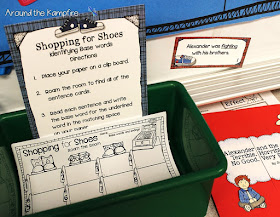In order to turn our readers into comprehenders we need
to go deep when working with a book. One of my very favorite
books that makes reading for meaning so much fun is
Alexander and the Terrible, Horrible, No Good, Very Bad Day.
Perfect for teaching students about cause and effect, it is alsorich with comprehension building opportunities for students to
make inferences, explore text structure, decode longer words,
as well as build social skills. It also lends itself perfectly
to all types of writing. We did so much with this book that
I'll be sharing it all in a 4-part series, so stay tuned for the
additional posts!
Take a peek inside my classroom and see all of the ways we used
Alexander and the Terrible, Horrible, No Good, Very Bad Day
to dive in deep!
Identifying Cause & Effect
Alexander's day, while terrible and horrible (Poor little guy),
is rich with opportunities for identifying cause and effect relationships.
I have several copies of the book purchased with Scholastic points
so I had groups of students work together to identify events with
causes and effects then write them on sticky notes.
Partners also worked with sentence cards from the story to match
the cause to the effect.
After collecting causes and effects in their groups, students
wrote them in this multi flow map that folds into a
cause and effect trifold.
During our literacy centers students made flapbooks and
later added them to a culminating Alexander booklet.
Working with Vocabulary
a book we are working with. I like to have students work with
words that not only increase their vocabulary but also give
opportunities to work with grammar and spelling patterns.
Students matched words to definitions then used the
vocabulary in open ended, written responses.
so they can use the table top pocket charts!
to add to their Alexander booklets.
Decoding Longer Words
Like all teachers, I have a wide range of reading abilities in
my classroom. This book is a treasure trove of multisyllable
words to work with and I pulled words from the book to make
this flapbook activity. With two versions it serves double duty
as a small group work mat that is easily differentiated.
I copied the book cover and word cards on bright card stock
then pulled the mats I needed for my different groups.
Making Grammar Connections
We worked with story statements to identify base words and endings in this roam the room activity.
My kids love to use clipboards and moving around the room
keeps them engaged while getting some of their wiggles out.
Persuasive Letter Writing From
A Character's Point of View
At the end of each week my class writes Friday letters to
their parents telling what they've learned and the highlights
of their week. I always have students end their letters with
a question their parents can answer when they write back.
We save these each week and I bind them into a book at the
end of the year. This week we did something a little different.
their parents telling what they've learned and the highlights
of their week. I always have students end their letters with
a question their parents can answer when they write back.
We save these each week and I bind them into a book at the
end of the year. This week we did something a little different.
asking "Can we move to Australia?". Students tried to convince
their parents that moving to Australia is a good idea!
their parents that moving to Australia is a good idea!
While we'll be binding our letters into our Friday Letters books,
another option is to use the Alexander craft to display them.
This book holds so many possibilities for different types of writing.
I took advantage of that fact and we did several types of writing
while working with this book. I'll share those in an upcoming
post in this series.
Creating a Timeline
As an extension activity, a group of my students created this
flow map type timeline of Alexander's day.
They first made a list of all the key events then wrote
and illustrated each event on an index card. After sequencing
the cards in story order, students glued them onto a large piece
of butcher paper. I love how this cooperative effort turned out!
Alexander Foldable Lapbooks
As a culminating project we put together all of our minibooks
and writing into these Alexander foldable booklets.
Students included summaries of the story and
wrote about some solutions to Alexander's problems.
We did so much more with this book that I'll be sharing it all
in a 4-part series. I hope you'll stay tuned for:
Opinion Writing: Will Moving to Australia Solve Alexander's Problems?
Invisible Pictures: What Would Alexander's Teacher Say?
Building Social Skills with Alexander and the Terrible, Horrible,
No Good, Very Bad Day
Thanks for reading along!
Click to find more book studies and related resources.
For more literacy ideas and inspiration be sure to follow my
All Things Reading Board on Pinterest!





















Linda... these lessons are great and so creative! You're so talented. :)
ReplyDeletenice
ReplyDeleteThis book is actually good when it comes to teaching our students and even our children the good and bad effects of every decisions that we may. Through this we can teach them a sense of responsibility just like how it is being used by http://www.papersboard.com/custom-essay to teach and nurture their students.
ReplyDelete